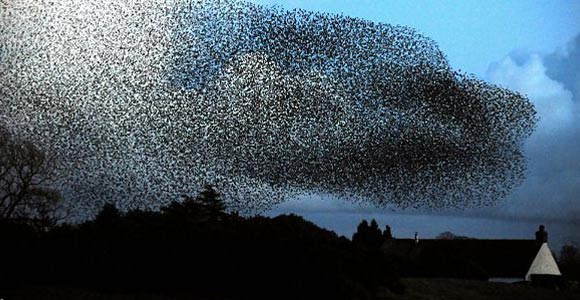
This amazing video by Mark Rigler demonstrates the beautiful complexity that exists throughout the natural world. Like a Bach fugue, patterns emerge and fade, interweave, and are exquisitely modified to form an endless variety of beautiful structures. The end result seems too complicated, too ordered, too apparently designed to have appeared by chance. But, like the fugue which is built from just one or two simple musical patterns, the dance of the starlings is choreographed from only a few simple rules, which scientists are now only just beginning to decode.
Across the animal kingdom, large numbers of similar individuals will group together. There are a number of good evolutionary reasons why they should do this. Penguins, in the dark Antarctic winter, huddle together to share their collective warmth. Herds of zebra gather on the Serengeti plains. With their eccentric, monochromatic outfits, the zebra can confuse predators, who find it difficult to distinguish any one individual animal. Schools of fish self assemble, for one is much less likely to be eaten if surrounded by a large number of equally tasty brethren.
It’s not known exactly why starlings flock in such large numbers. It could be that they are gathering to keep warm, like the penguins. Or like the fish, they are insuring themselves against being eaten by larger foes. Whatever the reason, it is a compelling one; starlings can gather in numbers of over a million.
So, what are the rules that cause the patterns you can see in the video above. Based on a sophisticated computer model, scientists from the University of Groningen calculated the following rules. The first is that, across the flock, there is little variation in the speed of any one bird. This might seem counter-intuitive – if there is little change in speed there should be little change in shape. However, should the flock decide to change direction, because they are all flying in the same speed, birds that were flying side by side would now by flying in single file. A long, narrow flock could change instantly to a short, wide one.
Fish school behave differently. Should the group decide to change direction, each individual fish can adjust its speed to maintain its original 3d position in the school. Fish schools are, therefore, a lot more stable; they dance to a much more simple tune than that of the starlings.
Where do changes in direction in the flock come from? Starlings typically flock above their nesting sites. Should some birds find themselves too far away from home, they will adjust their course. Since every bird is interactive with those nearby, the movement of one bird drags along that of the others, like an over enthusiastic dance partner. If flocks are dense, the number of partners each bird has increases. This actually acts as a stabilising force, as individual movements from any one bird become cancelled out. Just imagine 50 people all trying to do the foxtrot – they very likely wouldn’t move an inch. With less partners, individuals are free to roam where they like, causing chaos in their wake.
There are a few other reasons why birds might change direction. Collisions are an obvious worry in a group so large, so obviously this will need to be taken into account. Altitude can change simply by the way birds turn. If they roll (rotating along the axis from the head to the tail), they generate less lift. If they turn more gently, they can stay aloft longer.
Birds, like all life, will always be more complicated in reality than in a computer model, and obviously many of the reasons why the birds move in their characteristic way have been ignored. But, with only a few simple mathematical rules, we now have a pretty good understanding of how birds of a feather flock together.
Hemelrijk, C., & Hildenbrandt, H. (2011). Some Causes of the Variable Shape of Flocks of Birds PLoS ONE, 6 (8) DOI: 10.1371/journal.pone.0022479